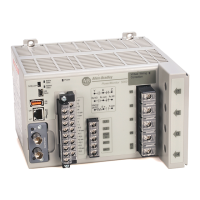Rockwell Automation Publication 1426-UM001J-EN-P - August 2019 499
Glossary
The following terms and abbreviations are used throughout this manual. For
definitions of terms not listed here, see the Allen-Bradley® Industrial Automation
Glossary, publication AG-7.1
.
Aggregation In power quality measurement, the process of computing a value from multiple
measurements over a defined time interval. The value is computed by taking the
square root of the arithmetic mean of the squared input values over a defined
time interval (that is,180 cycles, 10 minutes). See EN 61000-4-30 standard for
more information.
Amperes (A) The units of electrical current or rate of flow of electrons. One volt across one
ohm of resistance causes a current flow of one ampere. A flow of one coulomb per
second equals one amp.
Apparent Power The product of voltage magnitude and current magnitude in a circuit. Units are
VA or some multiple thereof.
Balanced Load An alternating, current power system consisting of more than two current
carrying conductors in which these current carrying conductors all carry the same
current.
Billing Demand The demand level that a utility uses to calculate the demand charges on the
current month's bill. Various methods can be used to determine the value, such as
minimum demand, peak demand, or a ratchet clause. The value can be based on
Watt Demand, VA Demand, VAR Demand, or some combination of these
values. A rate at which a transmission occurs, where one baud equals one bit per
second.
Burden The electrical load that is placed on source of VA or the load an instrument or
meter places on a current or potential transformer. All current and potential
transformers have a rated burden that cannot be exceeded or else transformer
transformation accuracy deteriorates.
Capacitor A device consisting essentially of two conducting surfaces that are separated by an
insulating material or dielectric. A capacitor stores electrical energy, blocks the
flow of direct current, and permits the flow of alternating current to a degree
dependent upon the capacitance and frequency. Capacitors can also be used to
adjust the power factor in a system.
Connected Load The total load that a customer can impose on the electrical system if everything
was connected at one time. Connected loads can be measured in horsepower,
watts, or volt-amperes. Some rate schedules establish a minimum demand charge
by imposing a fee per unit of connected load.
Crest Factor A measure of the amount of distortion present in a waveform. Crest Factor can
also be used to express the dynamic range of a measurement device. Crest Factor
is the ratio of the peak to the rms. For a pure sinusoidal waveform, Crest Factor
equals the square root of 2 (1.414).
Current (I) The flow of electrons through a conductor, which is measured in amperes.

